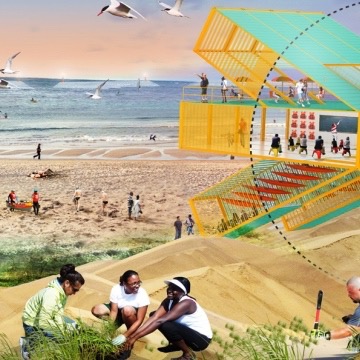November 11, 2014 — Earth’s rising temperatures mean more glacier melt, sea-level rise and severe weather, and this translates to heightened threats for coastline communities. In response, SCAPE Landscape Architecture — powered by President Obama’s Rebuild by Design Initiative — has proposed an innovative way to protect coastlines that also promotes biodiversity, environmental education and traditional livelihoods.
Instead of creating one conventional levee to protect the coastline from storm surges, Living Breakwaters uses innovative design to address the ecological and social impacts of wave mitigation. With community input, the design team developed a system of layered breakwaters — thick sections between land and water — that provides multiple rows of protection parallel to the shoreline. Layers consist of sloped mounds that help dissipate waves before they hit the shore. Each breakwater layer is designed to accommodate one specific type of naturally occurring underwater ecosystem. Called “reef streets,” these pocket ecosystems provide habitat for oysters, lobsters, juvenile fish and other organisms.
Unlike traditional levees, which often barricade the beach. Living Breakwaters provides recreational shoreline and makes it possible to preserve water-based traditions. Coastline accessibility fosters economic resilience and education, and local schools are able to gain hands-on experience learning about oyster ecology.
The system was recently named winner of the 2014 Fuller Challenge for socially responsible design by the Buckminster Fuller Institute. SCAPE has proposed pilot testing the project on the south shore of Staten Island, New York, and aims to one day adapt the system to shorelines across the United States. ![]()
Ensia shares solutions-focused stories free of charge through our online magazine and partner media. That means audiences around the world have ready access to stories that can — and do — help them shape a better future. If you value our work, please show your support today.
Yes, I'll support Ensia!
